 |
 |
| 日本昭和村 Japan Showa Village [Photos taken on Nov.22, 2003] |
| 2003年11月22日岐阜県美濃加茂市の道の駅に併設された平成記念公園「日本昭和村」 へ行きました。 特にアトラクションはありませんが、豊富な体験(蕎麦打ち、染色、陶芸、炭焼き、パン、 バター、籐クラフトなど)が安価で準備され、昭和の建物が適当に散在しています。 当日は昭和村の入口から最も離れた所にあるボート乗り場に接した広場でシンセサイザー の生演奏が行われていました。約20m位離れた両サイドにスピーカが置いてあり、気持が 良い音が響き渡っていました。 自然ふれあいゾーンでは山羊、ロバ、うさぎと触れ合えます。 山羊は100円の餌をやろうとすると、我先にと寄って来て食べます。良く見渡してみると、 1頭か2頭が人が気づかない離れた所にいて、その羊だけは餌にありつけないようでした。 最初からわかっていれば、平等に餌を与えたのだが。 午後1時半から蕎麦打ち体験を楽しみましたが、これはお勧めです。 体験して腹一杯 食べて1000円。場所は明治31年に建てられた小学校を移築復元した「やまびこ学校」 の入口を入ってすぐ右の1階の部屋。(下記説明参照) 2003年12月20日銭湯がオープン予定。入園しなくても利用できます。 I went to the Heisei commemoration park "Nihon Showa Mura" (literally translated as "Japan Showa Village" put side by side at the station of road in Minokamo City, .Gifu Prefecturre. Although there is no special attraction, abundant experiences (such as dyeing, making of buckwheat-noodles, pottery, charcoal, bread, butter, rattan craft, etc.) are prepared cheaply. In addition, the buildings reminding Showa era (1926-1989) are suitably arranged. The live music by a synthesizer was being performed in the open space where each speaker was put at both sides at intervals of about 20 meters. Comfortable suond echoed. In natural-touch zone, people can enjoy the contact with a goat, a donkey, and a rabbit. When I tried to feed them with food sold for 100 yen, they strived to come to me to be first. One or two sheep, that were in the distant place and could not be noticed, lost chance to eat the food. It is regrettable. Next time, we will look around to feed equally. I enjoyed an experience of buckwheat-noodles making from 1:30 p.m which is highly recommendable. The experience of making and the eating cost only 1,000 yen all toghether. The place is just at the right hand side of the inside of the entrance of "Yamabiko Gakko" school. Public bath opened on December 20, 2003 will be able to be used without entering "Nihon Showa Mura". ≪ルート、所要時間及び入園料≫ 国道248号と国道41号で自宅がある瀬戸市から車で約1時間30分。 入園料: 大人800円 ≪Route, time required and entrance fee≫ It takes about 1 and a half hour by car through National roads No. 248 and No. 41 to "Nihon Showa Mura" from my home in Seto City. Entrance fee: Yen800 for adult ≪体験の概略≫(写真参照) 時間:予約受付→午後1時; 体験→午後1時半から3時 料金: 1人1000円 そば粉(そば粉7割;小麦粉3割)を練り(そば粉300Gr、水140CC)、練って円くした状態を 落ち着かせる為に10分位寝かす。寝かした物に打ち粉(米粉)を掛けながら、厚みを ほぼ均等に延ばし、大体、正方形になったら、打ち粉を掛けながら適当な大きさに(3回) 折畳み、押さえ板でこの畳んだ素材に軽くあてがって、蕎麦切り包丁で切る。茹でると 1.5倍位太くなるので、細く切ると良いようです。ただ、これが結構難しいです。小生が 切った麺を茹でたら(約2分)うどん位の太さになったが非常においしかった。 ≪Outline of experience of making of buckwheat-noodles≫(See photo) Reservation is needed for this experience. Time the reservation is started: 1 pm Time of the experience: from 1:30 pm through 3:00 pm Charge: Yen1,000 for person Procedure to make buckwheat-noodles !. Mixi each flour of buckwheat flour and wheat flour in the ratio of 7 : 3 to make 300 gram in total. 2 Knead the above mixed flower (300 gram) with water (140 cc) to make the kneaded flower round 3 Leave the round flower as it is at least for about 10 minutes to stabilize the compound. 4 Extend the round compound while sprinkling buckwheat flour (or rice flour) to make the thickness almost equal and to make the shape almost square. 5 Fold the almost square compound in three. 6 Cut the folded compound with special knife for noodle while holding it lightly with a wooden plate suitable for cutting. * It will be better to cut the compound thinly because it will become thick (about 1.5 times) when boiling. 7 Boil the cut compound in a big pan for about 2 minutes. (The time depends on the taste for toughness.) This is my first experience, and I cut it rather thicker but the taste is wonderful. ≪やまびこ学校≫(写真参照) 「説明版」から引用。 岐阜県大野郡宮村の村立宮村小学校の旧校舎を移築、整備したもの。旧校舎は 明治31年に建てられ、当地に移築されるまでの104年間に約3,000人の卒業生を 送りだした。規模構造は、木造2階建て、述べ694平方メートル、間口38.2メートル、 奥行き9.1m。柱は、総檜材を使用しており、長い年月の風雪にも耐えた貴重な木造建築。 ≪Yamabiko school≫(See photo) The following are quoted from "Explanation board": Miyamura elementary school has been moved here from Oono county in Gifu Prefecture reconstructs here. The school was build in Meiji 31 (1899) and saw out about 3,000 school leavers for 104 years. The school of 2 stories is made of wood, having floor area of 694 square meters, the frontage of 38.2m, and the depth of 9.1m. The pillar is using hinoki (Japanese cypress), not synthetic wooden material. This school is the precious wooden structure which has weathered the snowstorm of long years. ≪珪化木≫(直立樹幹化石)(写真参照): 入園すると、すぐ目の前に珪化木があります。説明板での説明を以下に引用します。 要するに火山灰が降りかかった木が地中に埋もれ、珪素が化合した木のようです。 種名: タクソディオキシロン・セコイアヌム 時代:新第三紀中新世(約2,000万年前) 大きさ: 直径2.5m,、高さ1.6m、最大周囲7.8m(直径は日本最大級) 重さ:約11t 産地: 平成記念公園(野外活動ゾーン地域牧場付近) 解説: 約2,000万年前の蜂屋累層と呼ばれる地層から発見された。火山活動で 噴出した火山灰などに立木の状態で埋もれ、地層中のシリカ(二酸化珪素)に置き 換わって珪化木になった。 樹種は現在のスギ科のセコイアやメタセコイアに近い 仲間と考えられる。 この近くの蜂屋累層からはたくさんの珪化木が見つかることから、 当時は大森林が繁茂していたと思われる。 ≪Keikaboku (Upright tree trunk fossil≫(See photo) Keikaboku stands just in front of the entrance gate. Please refer to description at the explanation board for detail. In short, it seems to be the tree which volcanic ashes fell on, and was buried in the earth and then silicon combined.with.. Kind: Taxodioxylon sequoianum Time: The Miocene epoch period in the new Tertiary (about 20 million years before) Size: Diameter 2.5m, Height 1.6m, maximum circumferences 7.8m (The diameter is the greatest in Japan) Weight: About 11t Place of origin: Heisei Commemoration Park (near pasture in a field activity zone ) Description: This was discovered from the stratum called Hachiya Ruiso stratum in about 20 million years ago. The discovered tree was buried in the volcanic ashes which blew off by volcanic activity in the state of the standing tree, and replaced the silica in a stratum (silicon dioxide), and became Keikaboku. The kind of tree is considered to be a family near sequoia and metasequoia of the department of present Japan cedar. Since much Keikaboku is found from Hachiya Ruiso stratum near this area, it is thought that big forest had grown thick those days. ≪引き馬≫(写真参照) 子供はポニー、大人は白馬で専任の人が引いてくれる馬に一周100m位のコースを乗る。 料金:大人600円 ≪Horse led and ridden on≫(See photo) A child rides on a pony and an adult rides on a white horse. Then, a full-time man leads the horse through a round 100m place course. |
| やまびこ学校(ここで蕎麦打ち体験をした) Yamabiko school (experience of buckwheat-noodles making) |
 |
| 蕎麦打ち≪左→右へ≫buckwheat-noodles making≪left→right≫ 完成までの所要時間:約1時間 Time needed for the completion: about 1 hour |
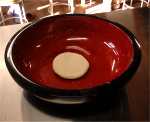 |
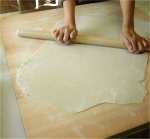 |
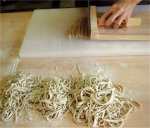 |
 |
| 引き馬 Horse led and ridden on |
どんぐり号 Circulating bus, "Donguri-go" |
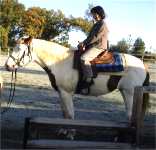 |
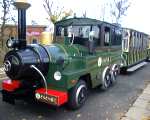 |
| 珪化木 Keikaboku |
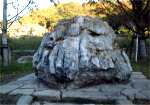 |
| 盆栽 Bonsai (dwarf) |
|
 |
 |